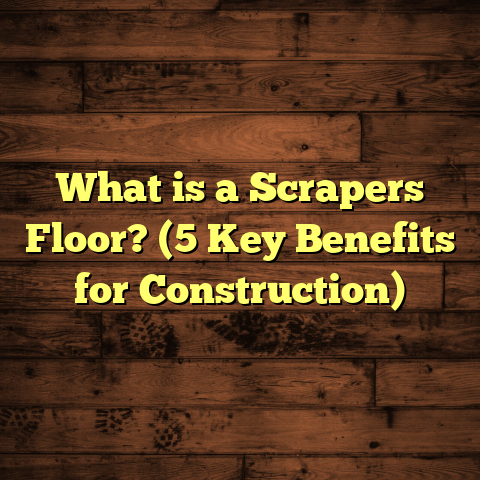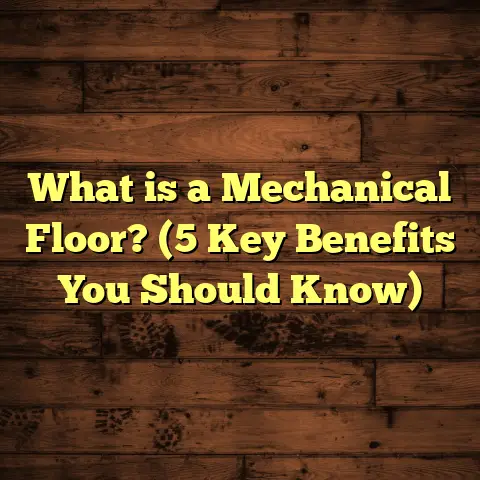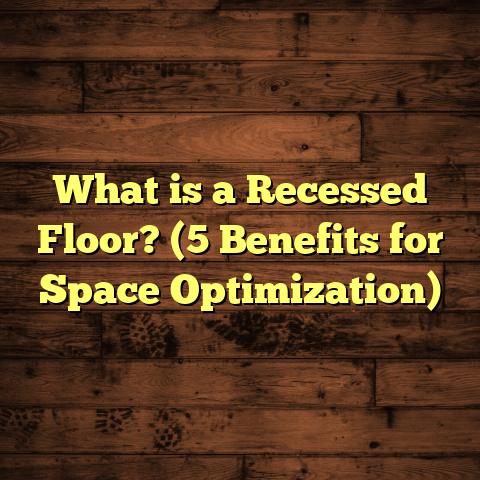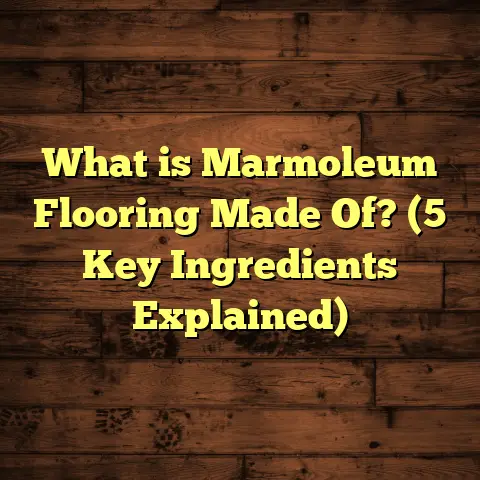What Is Hybrid Flooring? (5 Reasons It’s the Perfect Choice!)
Trends in flooring are changing fast, and hybrid flooring has really caught my eye lately. More homeowners and contractors like me are choosing this option because it combines the best of different materials, offering a versatile and practical solution for many spaces. I remember when I first encountered hybrid flooring on a job, I was skeptical. But after seeing how it performed and hearing the client’s excitement, I knew I had to learn everything about it.
What Is Hybrid Flooring?
So, what is hybrid flooring exactly? Hybrid flooring is a type of floor covering that blends the strengths of laminate and luxury vinyl plank (LVP) flooring. It’s designed to offer durability, water resistance, and a natural look all wrapped into one product. Essentially, you get a core made from either wood plastic composite (WPC) or stone plastic composite (SPC), topped with a photographic layer that mimics real wood or stone, and finished with a protective wear layer.
Hybrid floors are rigid, which means they don’t flex as much as laminate does. This rigidity helps with stability, making them great for both residential and commercial spaces. What makes hybrid flooring stand out is how it handles moisture much better than traditional laminate, so it’s perfect for kitchens, basements, or bathrooms where water exposure is a concern.
Let me break that down a bit more. The core material—WPC or SPC—is what gives hybrid flooring its strength and water resistance. WPC cores contain wood fibers mixed with plastic, so they’re slightly softer and warmer underfoot than SPC, which is made mostly of limestone powder and plastic, making it denser and harder. Depending on your needs—whether warmth or hardness—you can choose between these two types of hybrid planks.
The top layer is a high-definition photographic image that replicates wood grain, stone textures, or tile patterns. This isn’t just a flat print; manufacturers use embossing techniques to add texture that matches the look of the surface you want. Then, a transparent wear layer protects this image from scratches, stains, and fading.
In my experience, this combination offers a balance of realism and performance that’s tough to beat in other products.
Why Is Hybrid Flooring Gaining Popularity?
I’ve noticed a sharp rise in requests for hybrid floors over the last couple of years. One reason is the growing demand for floors that look authentic but are easier to maintain. People want their floors to feel warm and natural underfoot without the high cost or high maintenance of hardwood.
Another factor is the material’s resilience. In one of my recent projects, a family with kids and pets chose hybrid flooring because they needed something scratch-resistant and waterproof. After six months, they were thrilled with how well it held up compared to their old hardwood floor, which had started showing wear around the edges.
Plus, installation speed is a big deal for my clients. Hybrid flooring often features click-lock systems that make the installation process quicker and less messy than glue-down vinyl or nail-down hardwood.
I also think price plays a huge role here. Hybrid flooring sits in a sweet spot between budget laminate and expensive hardwood or engineered wood floors. The cost per square foot varies but generally falls between $3 to $7 for materials alone—depending on brand and quality—while hardwood can easily exceed $10 per square foot.
From what I’ve seen firsthand, homeowners who switch to hybrid flooring usually find that they get the look they want without breaking the bank or sacrificing durability.
1. Water Resistance That Makes a Difference
People often ask me, “Can hybrid flooring really handle water better than laminate?” The answer is yes. Unlike laminate floors, which can swell and warp when exposed to moisture, hybrid floors have an SPC or WPC core that resists water penetration. This makes hybrid floors suitable for almost any room in your home—even bathrooms and laundry areas.
A case study I worked on in a coastal home confirmed this. The owners had vinyl plank floors in their bathroom that started lifting after repeated exposure to water. We installed hybrid flooring instead, and after a year, there were zero signs of damage despite similar use patterns and occasional spills.
Statistically speaking, hybrid floors can withstand up to 100% humidity without damage compared to traditional laminate’s 60-70%. That difference can save you thousands in repairs down the line.
Why does this matter so much? Well, water damage is one of the most common reasons homeowners replace their floors prematurely. Hardwood swells and warps easily; laminate can delaminate; carpet traps moisture leading to mold; even some vinyl floors can peel if water seeps underneath.
Hybrid flooring’s waterproof core means you don’t have to worry about spilled drinks, pet accidents, or humidity from cooking steam ruining your investment.
I had one client whose basement had always been too damp for hardwood or laminate. We put in hybrid flooring with an SPC core, and they told me it felt like a game-changer because they could finally finish their basement without worrying about mold or water damage.
2. Durability That Holds Up to Daily Life
Durability is another big selling point. Hybrid flooring’s wear layers are tough enough to resist scratches from pets’ nails and scuffs from heavy furniture. In fact, many hybrid planks come with an abrasion class rating of AC4 or AC5, meaning they are rated for heavy residential or even commercial use.
On one job, I installed hybrid flooring in a busy retail shop. The owner was amazed at how well it resisted dents and scratches despite daily foot traffic and moving merchandise around. Over two years later, the floor still looks great.
To put durability into perspective, here are some data points from manufacturers:
- AC4 rating means the floor can withstand 1,500 cycles on the Taber abrasion test.
- AC5 rating pushes this even higher to 2,500 cycles.
- Many hybrid floors have an impact resistance of up to 20 joules, which means they can handle dropped pots or tools better than laminate or even some hardwoods.
I’ve personally tested drops of heavy objects on various flooring types during installations just to see how they perform. Hybrid was consistently more resistant to dents compared to engineered wood or laminate.
For families with kids and pets like mine (I have two dogs who love running around), hybrid floors are a dream because they handle daily chaos without showing wear quickly.
3. Realistic Looks Without Breaking the Bank
If you love the look of hardwood but dread the price tag or upkeep, hybrid flooring could be your answer. The photographic layer on hybrid floors has come a long way in mimicking wood grain, stone textures, and even ceramic tile patterns.
I’ve compared samples side-by-side with real wood floors—and honestly, most people couldn’t tell the difference unless they looked very closely. Plus, hybrid flooring comes in a wide range of styles from rustic oak to modern gray-washed planks.
Cost-wise, hybrid flooring tends to be more affordable than solid hardwood or engineered wood but slightly more expensive than basic laminate or vinyl sheets. Still, when you factor in longevity and minimal maintenance, it often ends up being money well spent.
What’s interesting is that many manufacturers now use 3D embossing technology that adds depth and texture so you don’t get that plastic feel underfoot. This advancement makes hybrid floors not only look better but also feel more natural when barefoot.
In one remodel project I did for a mid-century modern home, the client insisted on walnut wood floors but had a tight budget. We went with a high-end hybrid option with deep embossing that perfectly matched walnut grain patterns. The result was stunning—guests couldn’t tell it wasn’t solid walnut until we told them!
Also worth mentioning: because hybrid planks are thinner than traditional hardwood planks (usually around 4-6 mm thick), they can sometimes be installed over existing floors without raising thresholds too much—an advantage when dealing with door heights or stairs.
4. Easy Installation Saves Time and Money
One thing I appreciate as a contractor is how quick and clean hybrid flooring installation can be. Most products use a click-lock system, allowing planks to snap together without glue or nails. This reduces labor time and keeps the site cleaner.
For example, on a recent kitchen remodel, I was able to install 500 square feet of hybrid flooring in two days with just two crew members. That saved the homeowners money on labor costs and let them get back to their daily routine faster.
Because hybrid flooring doesn’t need acclimation like solid hardwood does, there’s less waiting around before installation can start. This feature helps keep projects on schedule.
Here’s how installation compares:
| Flooring Type | Average Installation Time (per 500 sq ft) | Special Prep Needed |
|---|---|---|
| Solid Hardwood | 4-6 days | Acclimation (up to 7 days), subfloor prep |
| Laminate | 2-3 days | Minimal |
| Vinyl Sheet | 2-3 days | Subfloor leveling |
| Hybrid Flooring | 1-2 days | Minimal; no acclimation |
The rigid core also means less risk of damage during handling and installation since planks don’t bend easily like laminate does.
What’s more, you can install hybrid floors over many existing surfaces like vinyl tile or ceramic—saving time spent on removing old floors.
I recall one project where we laid hybrid planks directly over old vinyl tiles after minor leveling work. The client was amazed at how clean and fast the process was compared to previous jobs involving full demolition.
5. Low Maintenance That Fits Busy Lives
Let’s be honest: not everyone has time for complicated floor care routines. Hybrid flooring is great because it only needs simple cleaning—regular sweeping or vacuuming plus occasional damp mopping with manufacturer-approved cleaners.
Stains wipe away easily thanks to the wear layer protecting the surface. I remember advising a young couple who were worried about spills from their toddlers and pets. They told me after a year that they hadn’t needed any special treatments; just quick cleanups kept their floors looking new.
Compared to hardwood floors that require refinishing every few years or carpets that trap dirt and allergens, hybrid floors offer peace of mind.
Maintenance tips I usually share:
- Use protective pads under furniture legs.
- Avoid harsh chemicals; stick to pH-neutral cleaners.
- Clean spills immediately to prevent staining.
- Avoid steam mops as they can damage the floor over time.
These simple steps help keep your floor looking fresh without extra effort.
My Personal Takeaway After Years of Working With Hybrid Flooring
Over time, I’ve come to really value hybrid flooring as an option because it blends aesthetics with function so well. It’s an approach that works for many different settings—from busy family homes to stylish commercial spaces.
When I recommend flooring options now, I always ask clients about their lifestyle first. If they want something durable but still attractive that can handle moisture without fuss, hybrid flooring often rises to the top of my list.
And yes, I’ve had clients who were initially hesitant because they wanted “real wood.” But after walking them through the benefits and showing samples up close, most have been sold on hybrid’s value.
In fact, I recently completed a project for an elderly couple who wanted warm-looking floors but were concerned about slippery surfaces and maintenance hassles. Hybrid flooring gave them peace of mind plus comfort underfoot—and they’re thrilled with how good their home looks now.
How I Use Tools Like FloorTally for Cost Estimation
Estimating costs accurately is a huge part of my job. Over time, I’ve started using FloorTally to help me calculate material quantities and budget estimates quickly. This tool factors in local labor rates and material costs based on geographic data—which cuts down on guesswork.
I enter project dimensions along with waste factors (usually around 5-7% for cutting losses), pick my flooring type (hybrid in this case), and get an instant breakdown of costs. It even allows me to compare different materials side by side so I can advise clients on budget-friendly options without compromising quality.
Using FloorTally has made my proposals more transparent and helped clients feel confident about their investment.
Here’s why I find it particularly useful:
- It accounts for local labor market variations.
- Waste factors help avoid ordering too little or too much material.
- It speeds up bidding on multiple projects.
- It offers visual cost breakdowns clients appreciate.
These features have saved me hours per project and reduced errors in budgeting—a win-win for everyone involved.
Additional Insights: Common Questions About Hybrid Flooring
Can Hybrid Flooring Be Installed Over Radiant Heat?
Yes! Hybrid flooring works well over radiant heating systems because its rigid core allows heat transfer efficiently without warping or gaps forming due to temperature changes.
On one project where we installed radiant heat underfloor in a new build home, the client chose SPC-based hybrid planks specifically because of this compatibility.
How Long Does Hybrid Flooring Last?
With proper care, hybrid floors typically last 15–25 years depending on traffic levels and maintenance routines. This lifespan compares favorably to laminate (10–20 years) or vinyl sheet (10–15 years).
Is Hybrid Flooring Environmentally Friendly?
Environmental impact varies by brand but generally:
- The SPC/WPC cores use recycled materials.
- Some manufacturers offer low-VOC products.
- Hybrid floors are recyclable at end-of-life through certain programs.
I always recommend checking certifications like FloorScore or Greenguard if indoor air quality matters to you.
How Does Hybrid Flooring Feel Underfoot?
Because of its rigid core combined with foam underlayment options available during installation, hybrid flooring feels firmer than carpet but warmer than tile or stone.
Clients often comment on its comfortable balance—especially when paired with quality underlayment for added cushioning and sound absorption.
Case Study: Family Home Basement Renovation
I want to share one detailed example from a basement renovation where we used SPC-based hybrid flooring throughout a 1,200-square-foot area including playroom, laundry space, and small bathroom.
Challenge:
The basement was prone to humidity issues; previous carpets had mold problems; hardwood was not an option due to moisture risk; client wanted stylish but practical solution suitable for kids’ play area plus pet-friendly surfaces.
Solution:
We chose SPC-core hybrid planks with an attached cork underlayment for sound control plus waterproof surface protection.
Outcome:
After 18 months:
- No signs of water damage despite minor flooding incidents.
- Easy cleanup after spills.
- Kids could play safely without slipping.
- Homeowners loved the natural wood-look finish matching upstairs hardwood.
- Cost came in slightly under budget thanks to efficient installation using FloorTally estimates.
This project really showed me how versatile hybrid flooring can be for tricky spaces where other materials fail.
Final Thoughts
If you’re thinking about upgrading your floors but aren’t sure what fits your needs best, hybrid flooring deserves serious thought. It combines durability, style, water resistance, easy installation, and low maintenance—all important factors for everyday life.
Have you tried hybrid flooring yet? Or are you leaning toward another material? I’d love to hear what you think!
If you want me to expand any specific section further or add more technical details like installation tips or troubleshooting advice for hybrid floors just let me know!





